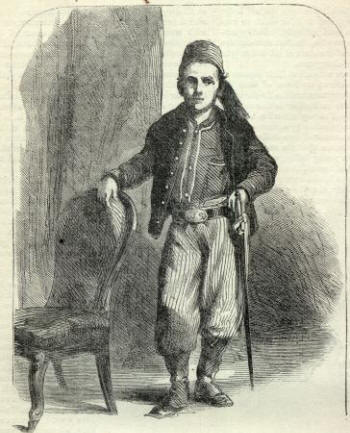
Please send all Checks and Money orders to :
Dave Taylor P.O. Box 87 Sylvania, OH 43560
419-842-1863
Click Here to E-mail Us!


16-12-01

16-12-01.. IDENTIFIED 7th OHIO CAVALRY BURNSIDE CARBINE… Fifth Model Burnside, also known as the �standard model.� These carbines show the improvement of adding a guide screw for the breechblock and are marked �Model of 1864� at top of the receiver, but are known to have been produced starting in 1863. This one has matching serial numbers 7491, sights, sling bar and ring, butt swivel, barrel band, etc. all in place. Good fit of wood to metal. Metal shows mostly gray with some mottled pewter tones on the lock and breech mechanism that are faded case. Some scattered darker spots. Clear serial number and breechblock markings. Lock markings a bit light but legible. �Cast Steel� barrel stamp. Wood has good, even tone, with overall scattered dings, scratches and handling marks from field use, but still shows the inspector cartouches at the wrist. Nicely carved in a long scroll on the right butt flat is the soldier�s name and unit: �W. CRAWFORD 7th OHIO.� This is William Crawford of Co. H, who enlisted on 8/30/62 and was mustered in as a private in that company on 10/27/62. He served throughout the war and mustered out 6/29/65. The regiment was formed in the Fall of 1862 and spent most of its service with the Army and Department of Ohio and from November of 1864 with the Military Division of the Mississippi. They were an extremely active regiment. CWdata lists 69 data entries where they suffered men killed, wounded or missing, and they lost 2 officers and 26 men killed in action or mortally wounded during their service at battles such as Carter�s Station, Mount Sterling, Dutton�s Hill, Mill Springs and Blue Springs. It chased Morgan�s cavalry and fought him at Cynthiana, was engaged in the siege of Knoxville and the Battle of Franklin. A scarce identified carbine carried by a member of a very active western theatre cavalry regiment. We don�t find soldier carved longarms but once in a blue moon. A dandy historical carbine $3,750.00
sold
Call us @ 419-842-1863
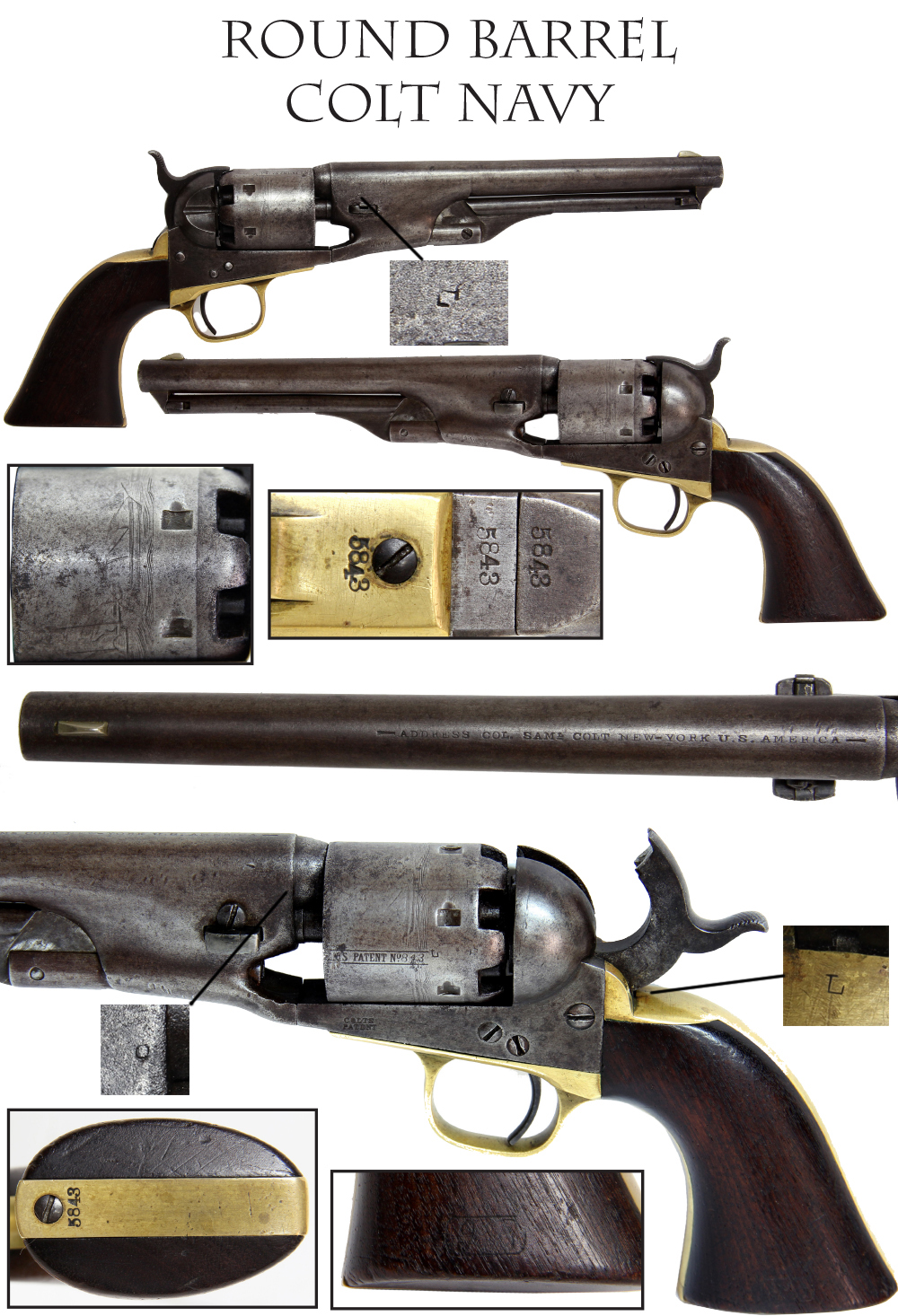
16-12-02..MARTIAL 1861 COLT ROUND BARREL NAVY… One of THE rarest of Colt�s is a martial 61 round-barrel. Also known as the 1861 Navy, Colt made some 38,000 of these streamlined versions of the six shot Navy from 1861 to 1873. Flayderman says they had reached number 28,000 by war�s end. Ours has matching serial number 5843, making it an early 1862 manufacture. Only several hundred were sold to the army and navy and this one shows the clear military inspector cartouche on the left grip. Tight wood to metal fit, mellow patina to the brass. Crisp numbering, barrel address and cylinder markings. Visible cylinder scene, beautiful grips with good edges and visible inspector cartouche on left butt. Sub inspector�s marks of L and O found on cylinder, back strap, left and right barrel lugs. Thin faded plum brown showing on the barrel over silver gray. Some darker mottling on frame that is the remnant of case hardening. Good action. This is a superior example of a pistol made in limited quantities with rare US martial acceptance marks. I will bet there is not another one of these martially marked 1861s currently on the market by any of my Civil War dealer friends � competitors. They are beyond scarce� $3,650.00
sold
Call us @ 419-842-1863

16-12-04… RARE WHITNEY 2 BAND INFANTRY RIFLE.. Among the enterprising Eli Whitney’s array of products were long arms made from machinery and surplus parts acquired left over from the bankrupt firm of Robbins and Lawrence, who had been producing Enfield pattern arms. Not willing to let anything go to waste, Whitney produced his own versions of the Enfield rifle musket and short two-band rifle, in several configurations. Some were supplied with patch boxes and were passed off as 1841 pattern US rifles. This is one of his Type IV variants mounted with his “mid-range” rear sight with a window and v-notch at the 300 yard range. Very clean wood. Metal smooth and in the bright. Some minor salt and peppering around the nipple and breech. Bands, slings, swivels, rod and side lug for a saber bayonet present. Total production was only about 600 and the government bought 500 directly from Schuyler, Hartley and Graham in 1861. Needless to say … this is one RARE Civil War rifle. $3,400.00
Call us @ 419-842-1863
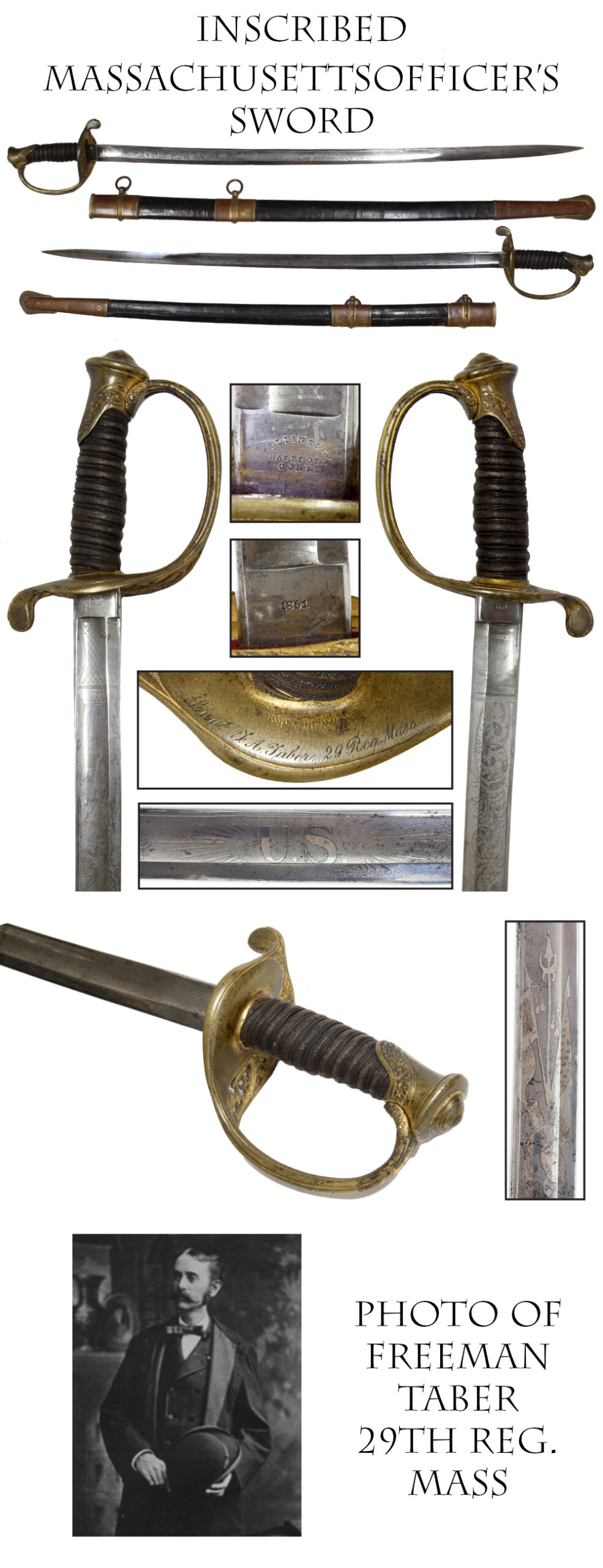
16-12-05.. IDENTIFIED IRISH BRIGADE OFFICER’S SWORD…. Regulation 1850 foot officer�s sword engraved on the guard with the name and regiment of a regimental Adjutant in the famed Irish Brigade. The sword was made by Collins and Company of Hartford, Connecticut, and has their maker stamp on one side of the ricasso and the date 1861 on the other side. Blade is a bright silver gray with traces of the original frosting. A �U.S.� etched on one side and trophy/stand of arms and flags on the other, both mixed with floral motifs. Full, dark gray sharkskin grip wrap in place with just light wear to the highspots, and wire binding in place and tight. Brass hilt has a mellow aged patina, with matching patina to the brass scabbard mounts. The leather scabbard is solid, with good finish to the black leather and just standard age lines and wrinkles. Engraved in period script along the inside edge of the sword guard is �Lieut. F. A. Taber 29 Reg. Mass.� The regiment was built upon seven companies of Massachusetts militia who had seen field service from May through July, 1861, with the 3rd and 4th regiments and then served briefly as a battalion before being brought up to regimental strength and designated the 29th Mass. Vols. in late 1861. Freeman Augustus Taber was a 21 year-old merchant in New Bedford when he enlisted on 12/16/61 and was commissioned First Lieutenant of Co. G. He must have been well thought of by the colonel, who transferred him to Co. E in mid-January to replace a First Lieutenant promoted to Adjutant, but it rubbed the men in the company the wrong way who regarded him as an outsider and thought their own Second Lieutenant should have been promoted. The problem was eventually solved on 6/15/62 when Taber was transferred to Co. A at the same rank, and soon after was himself assigned to duty as the regimental Adjutant, on 6/21/62. The regiment had been moved up to the front and assigned to Meagher�s Irish Brigade in the Second Corps on 6/9/62 and at that point were manning the entrenchments at Fair Oaks, where they were plagued by heat, rain, foul living conditions and daily harassment by Confederates that included an attack on 6/14/62. On 6/27/62 Lee opened the Seven Days Battles by sending Jackson against the right of the Union line at Gaines Mill and the Irish Brigade was one of two units rushed across the Chickahominy to buttress that flank. It engaged the enemy and formed a covering force for the retreating Federals. Over the next several days McClellan began his withdrawal back down the Peninsula and the Irish Brigade was part of the rear guard, fighting at Savage Station on 6/29, and White Oak Swamp and Charles City Crossroads on 6/30, the day Taber was listed as �missing.� In fact, he was one of many felled by exhaustion, disease and sunstroke during the period. The regimental history comments of the march ending on July 1, �During this time the weather had been extremely hot, the mercury ranging all the way from 90 to 100 degrees; and it therefore reflects no discredit upon the Twenty-ninth, that on this morning, after such unexampled hardships and sufferings, many of its most trusted officers and men failed to respond to the roll-call, and were reported �missing.�� Taber rejoined the regiment soon after, and was given a leave of absence for sickness, returned to Massachusetts and eventually submitted his resignation on the grounds of health in September. In later life he joined his brother in the photography business, working in Syracuse, NY, and in California. His name is well known among postcard collectors as the inventor of a process for making embossed postcards. $2,950.00
sold
Call us @ 419-842-1863

16-12-06… MASSIVE 1850’s IXL BOWIE KNIFE — HUGE! The largest Bowie I have owned outside of Confederate D-guard knives. Classic early American market Bowie knife made and marked by G. Wolstenholm and Son of Sheffield on the upper left side of the blade, with their motto “I*XL” on the ricasso of the knife and gilt blind stamped on the scabbard as well. This is virtually identical to their highly sought Rio Grande Camp Knife but much larger. Massive 10 inch long blade, 1 ½ inches wide just forward of the ricasso. Fifteen inches overall length. Stag horn grips with inset German silver plaque and German silver guard. Blade is spear point with a false back edge extending five inches from the tip. Smooth metal with a couple nicks and light evidence of polishing. Color a mix of light silver gray with a few grayer areas and spots near the hilt and tip. Scabbard is super showing some wear and abrasions. German silver throat and drag in place. Fastening button is missing from throat. The I*XL stamp and lower border lines are visible. The top borders are rubbed. About as cool a Sheffield Bowie knife as exists. $2,350.00
sold
Call us @ 419-842-1863
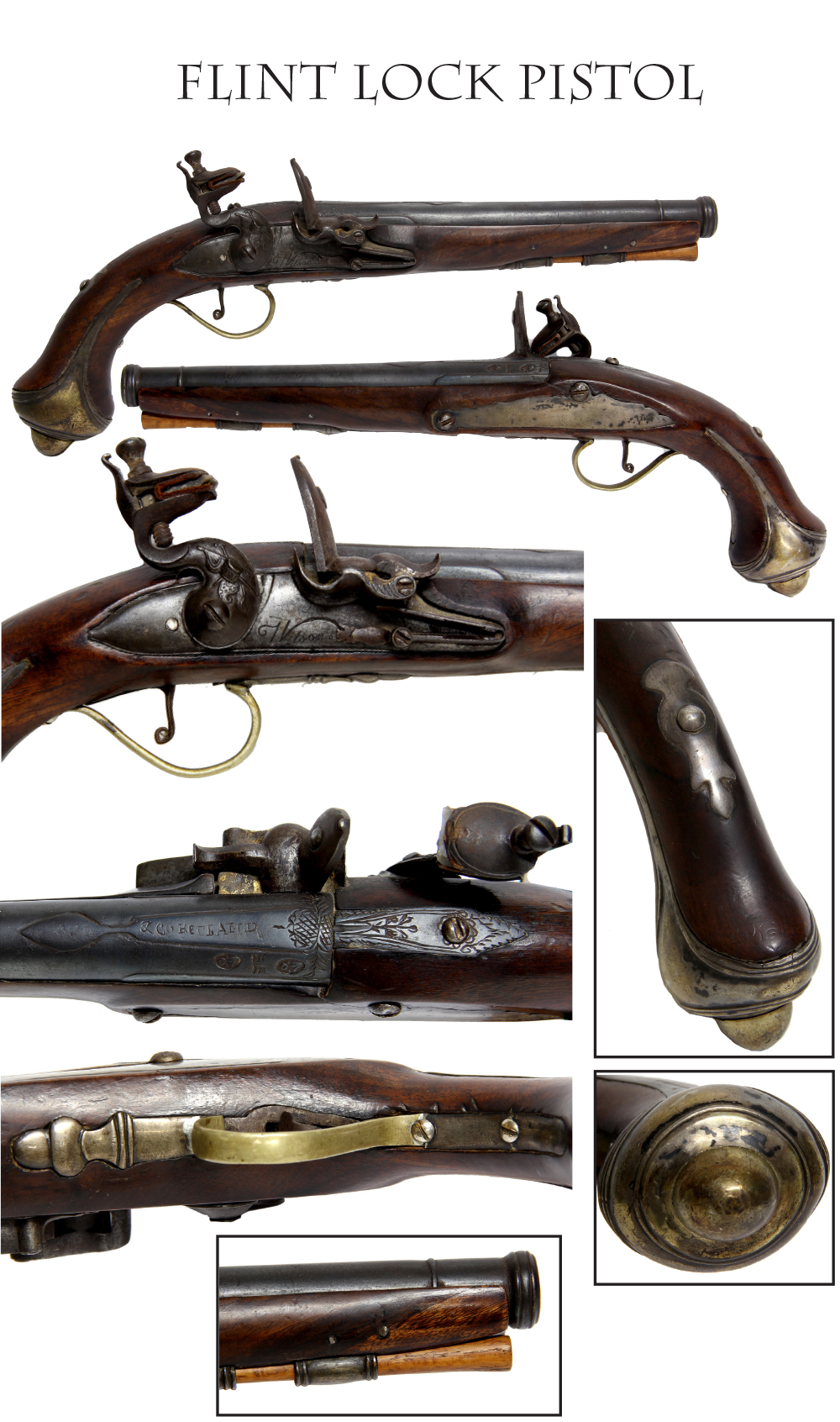
16-12-07… FLINTLOCK PISTOL CA 1780s…. Cannon barrel flintlock pistol with raised muzzle ring and astragal just behind it. Butt cap has spurs almost to the lockplate, and a prominent finial knob. Unusual iron thumbpiece on the back of the grip. Brass trigger guard has been repaired with a replaced bow. Small piece of wood replaced under the muzzle forward of the thimble. Plain, flat brass side plate with two lock screws. Hammer shows an ornate military trophy of drum, flag and other elements on the belly. The neatest flintlock hammer I’ve seen in a while. Very decorative and striking. Frizzen extends in a long serpentine spur. Barrel has been blued in the not too distant past. Top flat shows crudely engraved “& C0. ENGLAND” with some crudely engraved geometric and floral motifs that extend over the breechplug tang. The quality matches the impressive, if not very meaningfull proof and inspection stamps at left breech. The well-known English gunmaker’s name “Wilson” is engraved in the lockplate, likely to impress a gullible buyer. A nice period imposition flintlock meant to take advantage of the reputation of Wilson and the English gun trade in a foreign market. $895.00
sold
Call us @ 419-842-1863

16-12-08.. OHIO CAVALRYMAN’S SAVAGE REVOLVER: … The Savage Revolving Arms Company made about 20,000 of these �Navy� revolvers in .36 caliber and supplied something over 11,000 of them to the government. The double trigger arrangement was modeled on the North and Savage Figure 8 revolvers and these have always been a desirable and somewhat oddball collectible pistol as well as US martial sidearm. This one shows use, with the nipples showing hammer impact. The wood to metal fit is still tight. The metal is smooth grey steel. The barrel and frame show a mix of blue turned plum brown mixing with gray along the raised edges. The rest shows a mix of gray. Company marking and patent stamp visible on the top strap, rubbed along the bottom line. Mechanically hit or miss functional. Sometimes the cylinder indexes, sometimes it doesn�t. Gun cocks fine. Clearly carved on the upper left grip is �I Shobe.� We researched this one extra carefully. There are only five listings of soldiers named I Shobe in the entire Union army. The only candidate with cavalry service is Ohioan Isaac Shobe, who carries three of the five listings himself. He initially served as a private in the 20th Ohio Infantry and then transferred to cavalry by November of 1861. He enlisted as a private in McLaughlin�s Ohio Cavalry Squadron on 11/6/61 and served until 5/22/62, when he was furloughed from the Post Hospital at Ashland, Kentucky. More research needed there for explanation of why he was furloughed from the hospital and why he was there. Then, Isaac Shobe shows up in the Ohio records one more time: on 8/23/64 he enlisted as a private and mustered into Co. A of the 180th Ohio on 9/26/64. The date and method of his discharge from that unit are not listed. Pension records do not link him to the Isaac Shobe in the first two units, but it is likely the same man. McLaughlin Ohio Cavalry Squadron was named after Major William McLaughlin, who received permission from the Governor of Ohio to raise an independent command from the Mansfield, Ohio, area to serve for three years. It was sent to Kentucky, operated with Garfield�s 43rd Ohio Infantry and fought alongside them at the battle of Middle Creek. It did escort and picket duty, with occasional skirmishes until after it reenlisted as a veteran unit when it joined Sherman and served under Stoneman and then Garrard, taking part in the Atlanta Campaign, March to the Sea, and Campaign of the Carolinas. At the end of the war it was consolidated with the 5th Ohio Cavalry until muster out. The 180th Ohio served largely in Tennessee as railroad guards until being sent east to Washington and then to the North Carolina coast, where it saw some action near Kinston. It is recorded as losing 1 officer and five men killed or mortally wounded during its service. A very collectible Civil War handgun with a nice identification. $2,650.00
Sold
Call us @ 419-842-1863
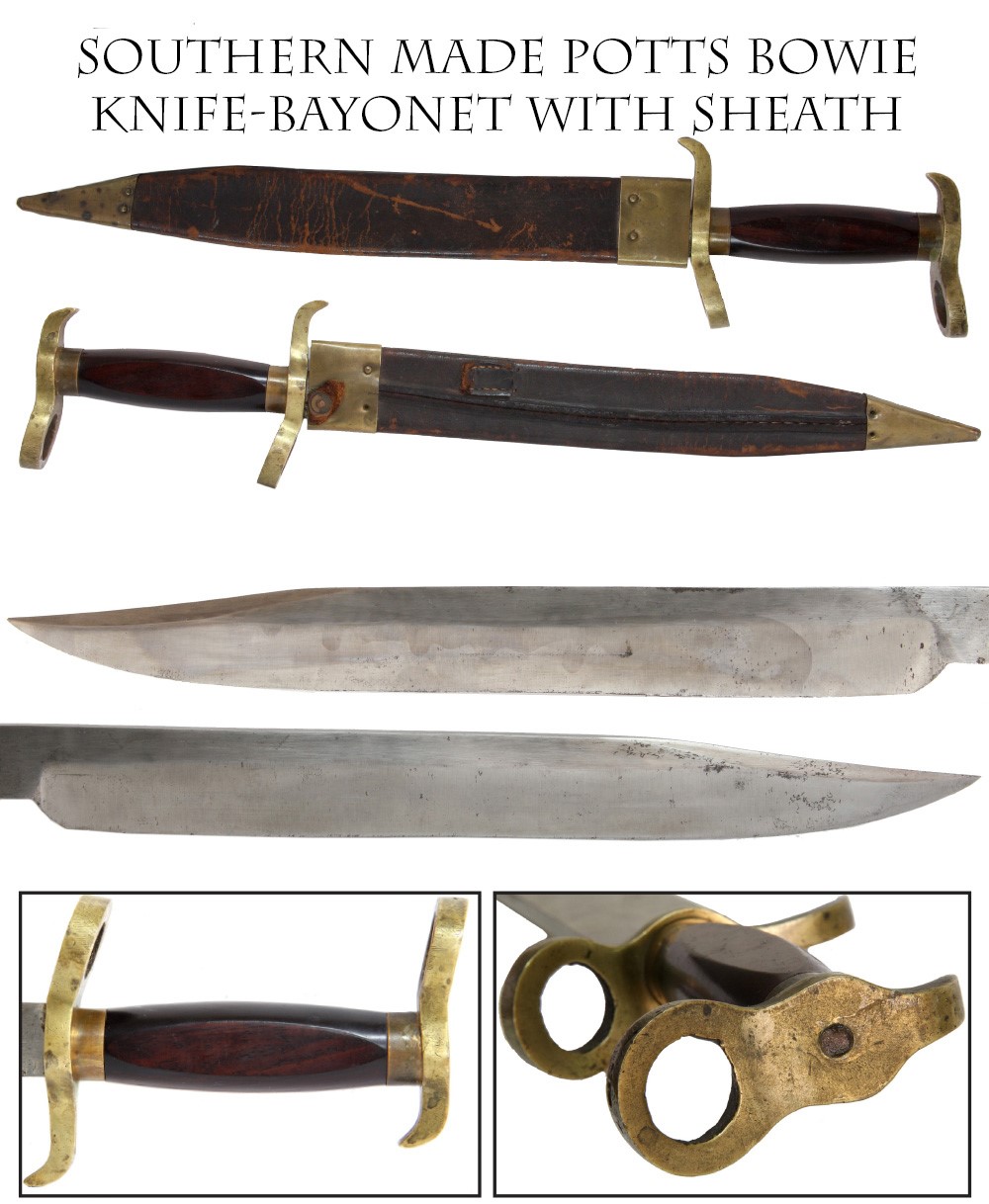
16-12-09… “POTTS” BOWIE BAYONET… These unmarked bowie bayonets are believed by some collectors to have been made by T.A Potts in New Orleans. The reason being� ONE example of this pattern among the hundred plus known specimens is marked �T.A. Potts New Orleans 1840�. My opinion is that the bowie-bayonet so marked bears a bogus maker�s stamp. The weapon itself is real but I wouldn�t give a dollar for the stamping. Some now believe these Potts knives were actually made by Rees Fitzpatrick of Natchez, Mississippi. They have always posed a question for collectors and scholars who call the rings extending from the guard and pommel �muzzle rings,� but note that the rings are always unfinished on the inside and have no provision to actually fix the weapon to a rifle barrel and keep it there, let alone in any one position. Most likely these were Bowie knives that doubled as Pole Arms by affixing the knife to a stout lance haft. More recently it has been rumored that an example surfaced with an old capture note indicating it had been used as a detachable spear point on the staff of a battleflag. It does make sense that the loops would be better adapted for a friction fit to a pole, whether for use as a flag finial or pike, but the research is still ongoing. It is a dead real Confederate sidearm in any case and a very stylish Bowie with swept back clip-point blade, and swept back muzzle or staff rings that accentuate the sleek profile. The forward, quillon ring on this has been bent back slightly. The grip is excellent and the blade is a bright, steel gray with just a few scattered gray spots below the false edge. The point and edge are excellent, with no nicks, grinding or polishing marks. As rare as the knife is, the scabbard is even rarer, and this one is in great shape. The leather is solid, with just minor scuffing. Brass throat and drag are in place, and best of all, the upper and lower portions of the leather belt loop are still there. This is a very cool looking Bowie, a scarce Confederate edged weapon, in very good condition, and a darn rare piece with its original scabbard. It will be a long time before another this nice comes along. Christmas is at hand and you owe yourself a present. $2,650.00$$
sold
Call us @ 419-842-1863
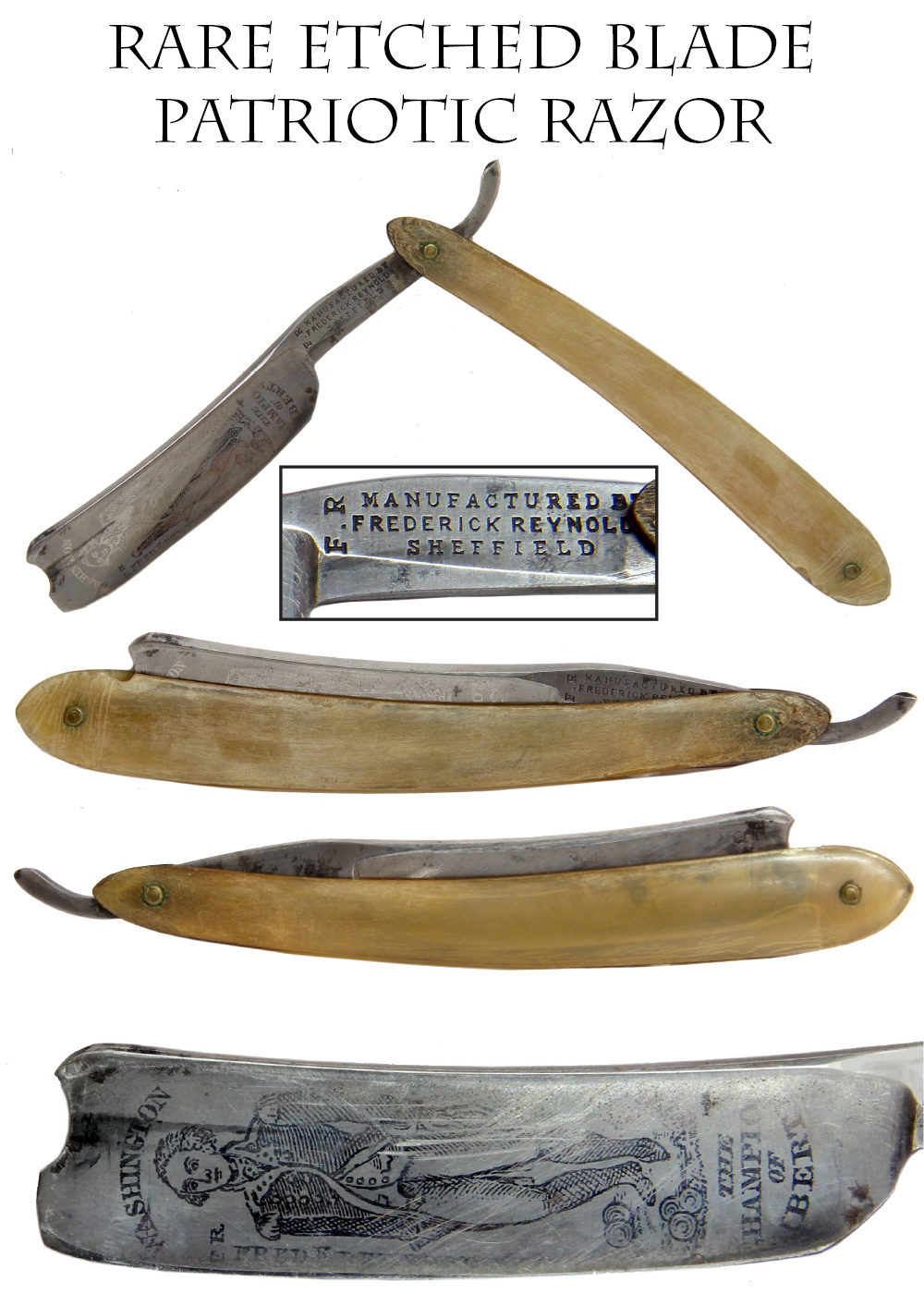
16-12-10… RARE ETCHED BLADE PATRIOTIC RAZOR… A nice horn-handled razor made by a British cutler for the American market and etched with a full-length portrait of George Washington no less. Stamped at the base with the maker’s name and initials: “F.R. Manufactured by Frederick Reynolds Sheffield.” The face of the blade is also etched along the edge with his initials and name, but is dominated by the portrait of Washington with his name in an arc above and the motto “The Champion of Liberty” below. There is some rubbing to the upper and lower edges of the etching (or left and right if you hold it with the figure standing,) but the main, central portion is very visible with good resolution. This is a striking patriotic piece of a patriotic man’s shaving set… $495.00
Sold
Call us @ 419-842-1863
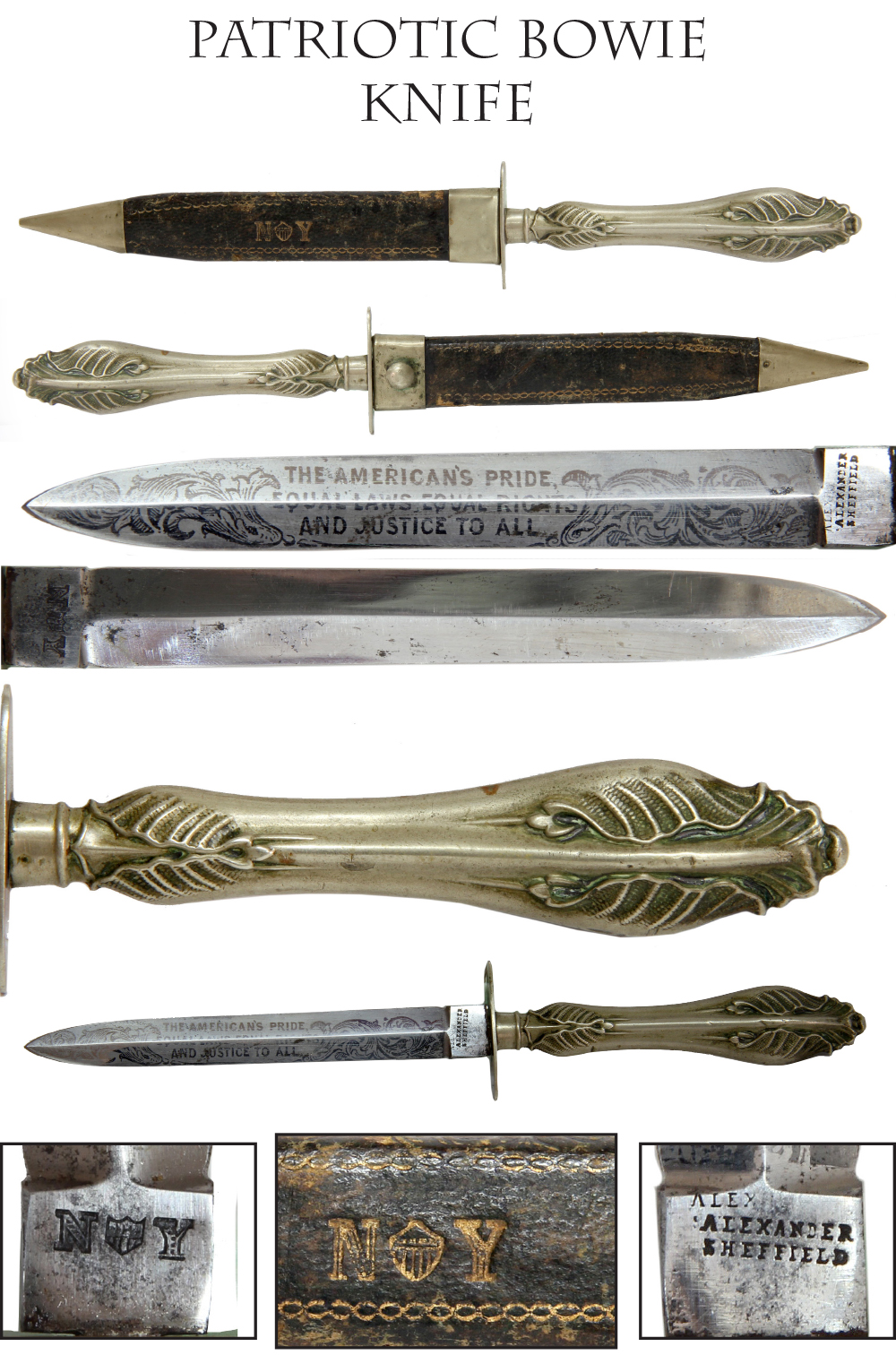
16-12-11… PATRIOTIC ETCHED BLADE BOWIE KNIFE… A straight-bladed, double-edged, spear point Bowie by Alexander of Sheffield made for the Civil War market of New York volunteers. Ten inches overall. Five inch vivid etched blade. Panel on the left: �The American�s Pride, Equal Laws, Equal Rights, and Justice to All,� with swirling floral motifs fore and aft. Reverse side is plain. Ricasso deeply marked �Alexander /Sheffield� on one side (with a faint false start of the top line,) and �N (shield) Y� on the other. The NY mark is repeated in a gilt blind stamp on the green leatherette scabbard that also has a gilt blind stamped border on each side. German silver figural handle, flat oval crossguard. German silver upper and lower scabbard mounts, and the small fastening button at the throat is present. Using the NY and shield motif was a savvy marketing ploy given the huge numbers of troops supplied by the state. This example is in extremely good condition with everything present. The unetched side of the blade is bright and the etched panel shows off from a distance with muted frosting and just a slight wear line on the raised central rib. A darn fine Civil War knife. $795.00
Call us @ 419-842-1863
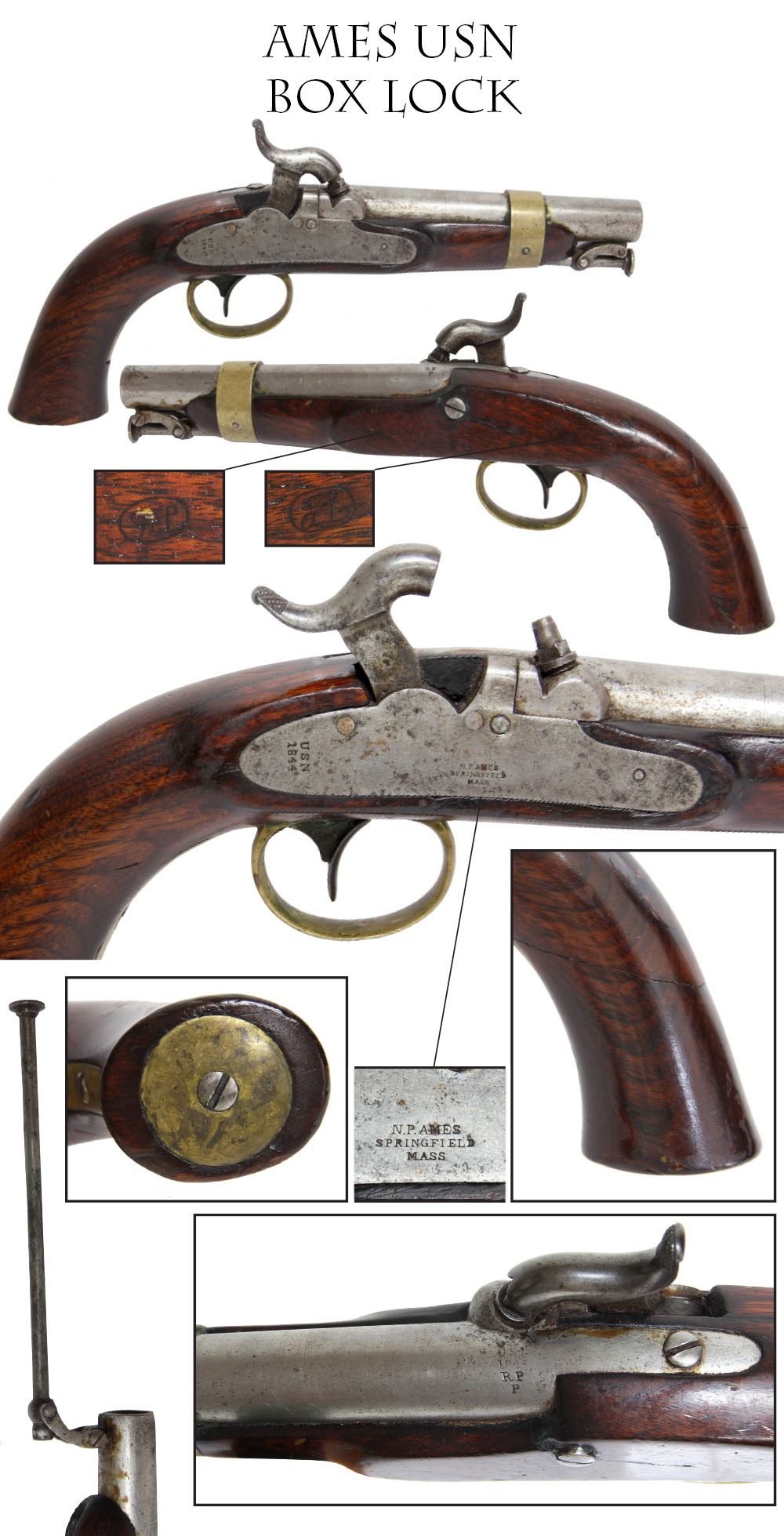
16-12-12… AMES USN BOX LOCK NAVY PISTOL… Model 1843 US Navy percussion pistol. .54 caliber, 6-inch barrel. Sometimes referred to as the Model 1843 or simply as the box lock, about 3,200 of these were manufactured between 1842 and 1847 with the production divided, 2,000 being made by Ames and 1,200 by Deringer, though only about 300 of Deringer’s were actually accepted. This was the first US martial percussion pistol, and featured a swivel ramrod, integral trigger guard and trigger plate, no backstrap, and a box-lock action. Barrel now in the bright, with smooth metal and just scattered darker gray spots. No sights, as is correct (though some have a simple front sight.) Nice medium tone to the brass barrel band. Pretty grain to the wood. One slight crack aft of the lock screw on the offside. Two visible military inspector cartouches on the offside. Clear NP Ames maker stamp on lower portion of lock plate and crisp USN/1844 vertical stamp to rear. Action good, nipple not battered. Brass disc buttcap in place. Matching USN/1844 barrel date at breech a tad light, but legible. Crisp RP/P barrel inspector/proof stamp and left breech. A very good example of a regulation Navy arm and the first US martial percussion pistol. $975.00
Sold
Call us @ 419-842-1863

16-12-13… OUTDOOR TINTYPE 9 YANKEES IN THE MUD: Nice large size quarter plate tintype with bright contrast showing a very candid portrait of nine Yankee Mud Marchers. Their boots and shoes are coated in mud. Image proper measures 4.25 x 3.25 inches. This one is quite appealing as it was taken from a slightly elevated position looking slightly down on the subjects. VG clarity with just a hint of softness. Housed in a half case with mat, frame, and glass. $1,250.00
sold
Call us @ 419-842-1863
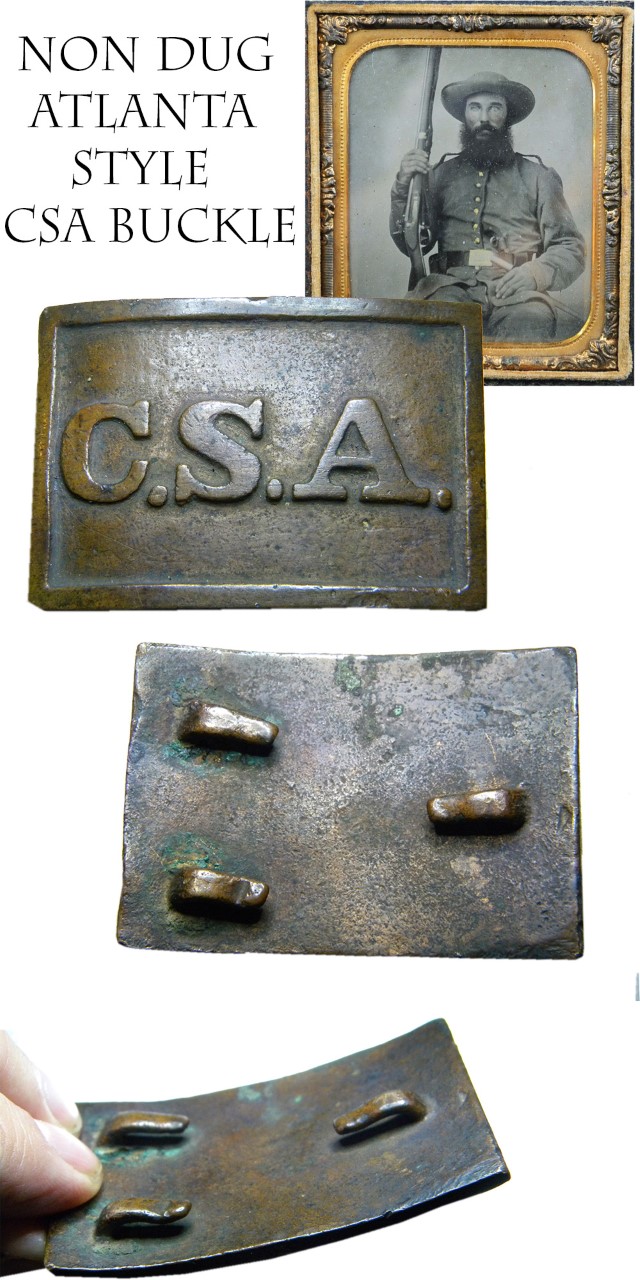
16-12-14… ATLANTA STYLE CSA BUCKLE:…. Hands down my favorite “standard” Confederate buckle… and this one is absolutely perfect. Perfect patina, 3 perfect hooks, and no casting flaws. About the prettiest example I’ve seen in years. Patina untouched since the war, and it could not be duplicated in another 150 years. Brought home by a New York yankee as a souvenir and never on the collector market previously. The absolute best specimen you can find. $3,850.00
sold
Call us @ 419-842-1863

16-12-15…STRIKING QUARTER PLATE THERMOPLASTIC UNION CASE… One of the scarcest of the Civil War thermoplastic tintype cases. One side of the case has cherubs on each side of a lyre or harp in a garden like setting. The other half of the case is starkly geometric with patriotic stars, perfectly balanced rolled scroll background setting, surrounding a perfect circle emblazoned with The Lord’s Prayer…. surrounding the Bible. I do not recall ever owning this gutta percha case previously and in the fall of 2016 I bought two of them from a friend who was settling an estate. Condition PERFECT. Inside the case is a beautiful quarter plate ambrotype of two beautiful sisters. Image is perfect except for a crack that runs through the right lower area of the view. The image is free… price is for the superior case.
$395.00
Call us @ 419-842-1863
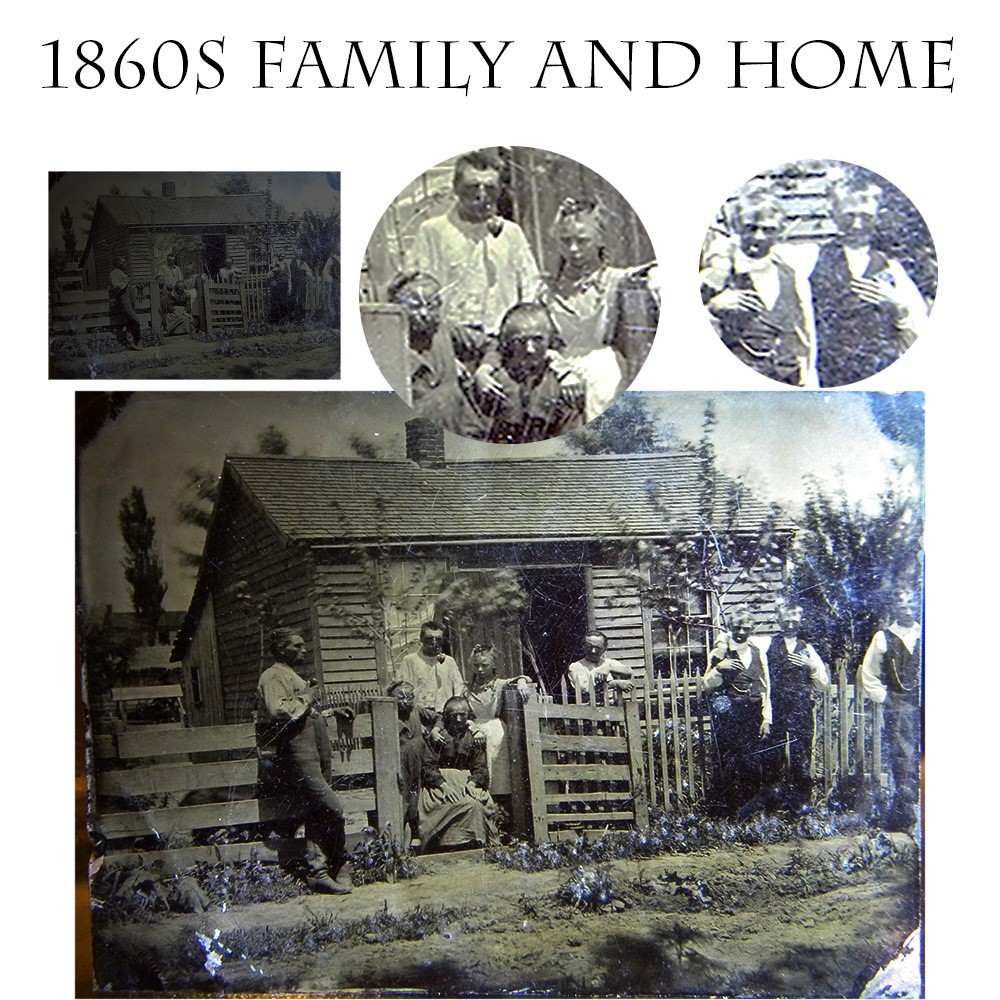
16-12-16…QUARTER PLATE TINTYPE FAMILY OUTDOORS AT HOME… A nice photographic slice of life at home in the 1860s. Little old clapboard house near town. Nine folk posed outside including a pair of dapper teenage lapel holders wearing vests on the right. On the left Pa is taking a pull on his big old pipe. Granny seated, two girls and oldest son are in the center. Grandpa is next… and then three older boys… Cousins??? Uncased quarter plate tintype. Contrast is somewhat grey as shown in the upper left. Clarity is excellent. Condition is VG with just a couple bends at the corners.. A neat old time outdoor image. $125.00
sold
Call us @ 419-842-1863

16-12-17…BRASS BULLET MOLD FOR JENKS NAVY CARBINE… One of the rarer bullet molds to find. 6 ½ inches overall. Three round ball cavities in 54 caliber. Marked “Wm. Jenks” and also stamped with a federal eagle’s head proof mark. Number 60 faintly visible stamped into brass as well. Shows use but no abuse. This is the only one of these I recall owning. Steel sprue cutter and guide-pin. Balance brass. $495.00
sold

16-12-18…SOUTH CAROLINA CONFEDERATE WEAPONS & EFFECTS OF CAPT. THOMAS KINCAID ANDERSON … I purchased this archive through a friend and fellow collector who was neighbors with the Great Great Grandaughter of T.K. Anderson. I made my check payable to Ms. Anderson when we consummated the deal. This grouping descended in the family until my purchase. They are a very prominent founding family of Fairfield County, SC, with roots going back to Colonial times. Accompanying this lot is the published history of the family with many entries on Thomas Kincaid Anderson and his connection to the Lost Cause. Typical large southern land owning families in the 18th century, had many family members involved in the militia starting with Cherokee Indian wars of the 1760s, Revolutionary War, War of 1812 where William Kincaid raised his own volunteer company. Several family members attended the Citadel including 2 of Thomas’ older brothers & a younger brother John who was killed near Atlanta August 31, 1864. Thomas was near his home when Sherman burned Columbia and was said to have buried the family silver & jewelry prior to Sherman’s “bummers” ransacking their stately home “House on the Rock” where this archive originated. The 100 page accompanying history is actually titled The House on the Rock. The U.S.C. Carolina Library has over 2500 family documents in the “Kincaid-Anderson” family papers which should be researched. This grouping includes 1) extremely rare “KRAFT, GOLDSCHMIDT & KRAFT” staff officer’s sword made in Columbia, SC; 2) South Carolina buff leather sword belt with 2-pc interlocking sword belt plate with South Carolina State seal; 3) Confederate brown leather holster with Colt Navy revolver SN 184564 which was made in 1865; 4) Confederate tin canteen with original canvas sling. All these items have same “as found” appearance with heavy patina. CONDITION: 1) Very good “as found” with 32″ single fullered blade. Blade etch is only partially discernible with old sharpening, “COLUMBIA” can still be ascertained on one ricasso & patriotic motif of crossed cannons is still partially visible. Blade overall is gray with staining & pitting & the old sharpening obscures most of the etch. Original scabbard body is sound & solid with iron patina. Hilt & brass scabbard mounts have dark grungy mustard/chocolate patina. Grip retains 95% of its orig leather though dry, cracked & scuffed. Orig thin brass wire is intact with dark patina. 2) White buff belt is sound & solid with soiling & staining & 2 reductions on top left side, about 1 x 1/2″. Buckle is fine retaining traces of gold plating with die-tamped SC state seal slightly bent. Tongue & wreath have matching “H” surrounded by 4-dot assembly mark, belt loops measure 51mm & is 89mm overall & identical assembly marked plate is not found in Mullinax, Kerksis, or Topper. Often sword belts were sold with swords but this belt predates the KG&K sword. Buckle has chocolate patina with plated highlights showing through. 3) Colt Navy all matching with dark iron patina with strong traces of bright blue in protected areas. Brass trigger guard & backstrap have strong traces of orig silver plate with overall mustard colored patina. Grips retain most of their orig varnished finish. Capt. Anderson’s initials are neatly scratched on buttstrap “TA”. Revolver has very tight action, a little wobbly between bbl & frame. There are 7 notches cut in right grip. Holster accompanying this gun is typical plantation made flap holster with odd brass finial, holster is sound & supple retaining good color with scuffing & cracking with losses & several cracks at muzzle end. Holster was resewn during its time of service for continued use. How did Capt. Anderson end up with this revolver that was made in 1865? There were Union occupation troops for several years after the war & there was continued violence among Southern conservative organizations in “unredeemed” South Carolina til 1877 when occupation troops were finally removed ending reconstruction. Anderson’s obituary & tombstone state his name as Capt. Thomas Anderson. Despite loads of family biography I have not yet been able to determine Anderson’s precise military designation. My feeling is that he may have been on staff duty, perhaps at the state level as opposed to Confederate Central Government. His obituary does state he was director of the State Penitentiary which was not far from the family home in Columbia. 4) Classic Confederate tin canteen measuring 6-1/8″ in diameter, 2″ wide with soldered tin spout, 3 tin loops with canvas sling missing its attachment but otherwise very good & “as found” with patina, rust & several dents & scratches, coarse cotton sling is about 50″ long & 1″ wide with soiling & staining. Ends attached with an old straight pin. Also accompanying this lot is an 18″ cylindrical tin document or map case with friction fit lid with Capt. Anderson’s son’s initials “EKA” scratched in the lid. Here is one heck of a spectacular Confederate lot. One of the best rebel groupings I have owned, and I am the first person to own it outside of the Anderson family. Priced very realistically at… $33,500.00
Call us @ 419-842-1863
Layaways are Welcome
Need to split your order into multiple payments? No problem! A simple 20% earnest money deposit will hold your item for you.-acf
You can then pay it off in easy installments that fit your budget.
Read Terms Here
Items to Sell? Contact Us
I am always interested in buying ANYTHING from the American Civil War… Guns, Swords, Civil War Muskets, Knives, Uniforms, Flags, Medals, Badges, Diaries, Letters, Autographs, Buttons, photographs, tintypes, daguerreotypes, Insignia, Camp Items, Battlefield Relics, canteens, Drums, Etc… Call 419-842-1863 and ask for Dave Taylor.

